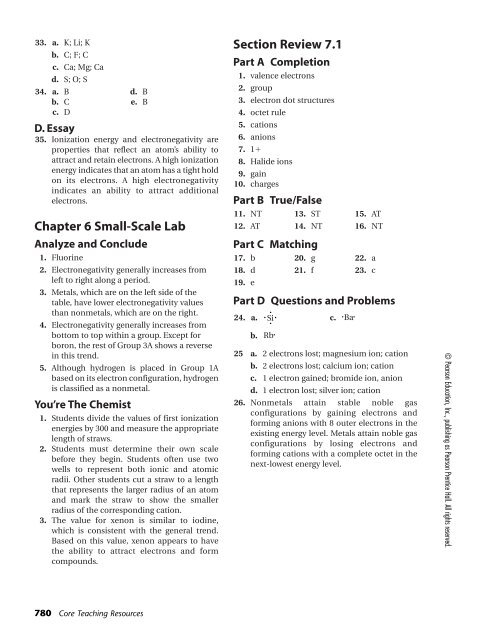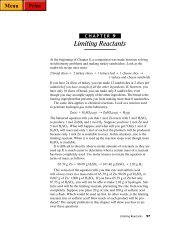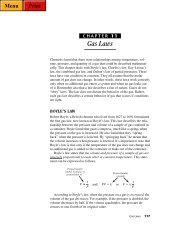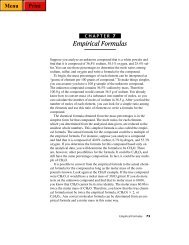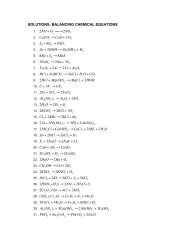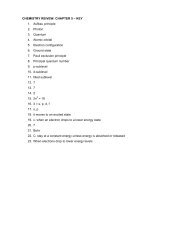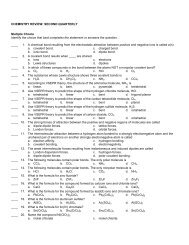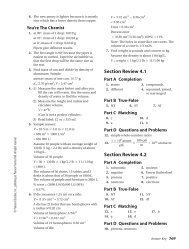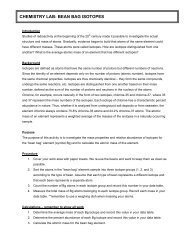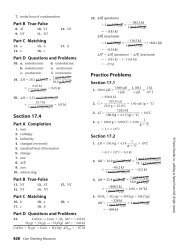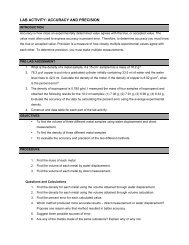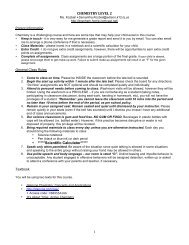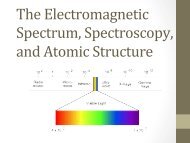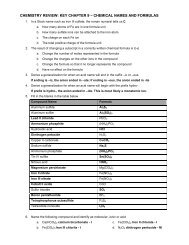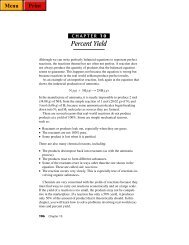Create successful ePaper yourself
Turn your PDF publications into a flip-book with our unique Google optimized e-Paper software.
33. a. K; Li; K<br />
b. C; F; C<br />
c. Ca; Mg; Ca<br />
d. S; O; S<br />
34. a. B d. B<br />
b. C<br />
c. D<br />
e. B<br />
D. Essay<br />
35. Ionization energy and electronegativity are<br />
properties that reflect an atom’s ability to<br />
attract and retain electrons. A high ionization<br />
energy indicates that an atom has a tight hold<br />
on its electrons. A high electronegativity<br />
indicates an ability to attract additional<br />
electrons.<br />
<strong>Chapter</strong> 6 Small-Scale Lab<br />
Analyze and Conclude<br />
1. Fluorine<br />
2. Electronegativity generally increases from<br />
left to right along a period.<br />
3. Metals, which are on the left side of the<br />
table, have lower electronegativity values<br />
than nonmetals, which are on the right.<br />
4. Electronegativity generally increases from<br />
bottom to top within a group. Except for<br />
boron, the rest of Group 3A shows a reverse<br />
in this trend.<br />
5. Although hydrogen is placed in Group 1A<br />
based on its electron configuration, hydrogen<br />
is classified as a nonmetal.<br />
You’re The Chemist<br />
1. Students divide the values of first ionization<br />
energies by 300 and measure the appropriate<br />
length of straws.<br />
2. Students must determine their own scale<br />
before they begin. Students often use two<br />
wells to represent both ionic and atomic<br />
radii. Other students cut a straw to a length<br />
that represents the larger radius of an atom<br />
and mark the straw to show the smaller<br />
radius of the corresponding cation.<br />
3. The value for xenon is similar to iodine,<br />
which is consistent with the general trend.<br />
Based on this value, xenon appears to have<br />
the ability to attract electrons and form<br />
compounds.<br />
780 Core Teaching Resources<br />
Section Review 7.1<br />
Part A Completion<br />
1. valence electrons<br />
2. group<br />
3. electron dot structures<br />
4. octet rule<br />
5. cations<br />
6. anions<br />
7. 1<br />
8. Halide ions<br />
9. gain<br />
10. charges<br />
Part B True/False<br />
11. NT 13. ST 15. AT<br />
12. AT 14. NT 16. NT<br />
Part C Matching<br />
17. b 20. g 22. a<br />
18. d<br />
19. e<br />
21. f 23. c<br />
Part D Questions and Problems<br />
24. a. Si<br />
c.<br />
b.<br />
Rb=<br />
=Ba=<br />
25 a. 2 electrons lost; magnesium ion; cation<br />
b. 2 electrons lost; calcium ion; cation<br />
c. 1 electron gained; bromide ion, anion<br />
d. 1 electron lost; silver ion; cation<br />
26. Nonmetals attain stable noble gas<br />
configurations by gaining electrons and<br />
forming anions with 8 outer electrons in the<br />
existing energy level. Metals attain noble gas<br />
configurations by losing electrons and<br />
forming cations with a complete octet in the<br />
next-lowest energy level.<br />
© Pearson Education, Inc., publishing as Pearson Prentice Hall. All rights reserved.
© Pearson Education, Inc., publishing as Pearson Prentice Hall. All rights reserved.<br />
Section 7.2<br />
Part A Completion<br />
1. electrostatic forces<br />
2. oppositely<br />
3. ionic bonds<br />
4. neutral<br />
5. formula unit<br />
6. crystals<br />
7. high<br />
8. large<br />
9. stable<br />
10. molten<br />
Part B True-False<br />
11. AT 13. AT 15. NT<br />
12. ST 14. ST<br />
Part C Matching<br />
16. b 18. c 20. a<br />
17. e 19. d<br />
Part D Questions and Problems<br />
21. Ionic bonds are the electrostatic forces of<br />
attraction that bind oppositely charged ions<br />
together. In an ionic compound, the positive<br />
charges of the cations equal the negative<br />
charges of the ions.<br />
22. When ionic compounds are melted, the<br />
orderly crystal structure breaks down. Each<br />
ion is then free to move throughout the<br />
molten mass. If a voltage is applied, cations<br />
will migrate to one electrode, and anions will<br />
migrate to the other. This movement of ions<br />
means that there is a flow of electricity<br />
between the two electrodes. When ionic<br />
compounds dissolve in water, their ions are<br />
free to move. Thus, aqueous solutions of ionic<br />
compounds also conduct electricity.<br />
Section 7.3<br />
Part A Completion<br />
1. cations<br />
2. electrons<br />
3. metallic<br />
4. electrical<br />
5. malleable/ductile<br />
6. ductile/malleable<br />
7. body-centered/face-centered<br />
8. face-centered/body-centered<br />
9. hexagonal close-packed<br />
10. alloy<br />
Part B True-False<br />
11. NT 13. NT 15. AT<br />
12. ST 14. AT<br />
Part C Matching<br />
16. d 18. b 20. a<br />
17. e 19. c<br />
Part D Questions and Problems<br />
21. Solid metals consist of closely packed cations<br />
surrounded by free-moving valence<br />
electrons, which make metals good<br />
conductors of electric current. As electrons<br />
enter one end of a bar of metal, an equal<br />
number leave the other end. Metal cations<br />
are insulated from one another by electrons.<br />
When a metal is subjected to pressure, the<br />
metal cations easily slide past one another.<br />
This behavior makes the metal malleable and<br />
ductile.<br />
22. The superior properties of alloys result from<br />
the cumulative properties of all the<br />
constituents of the alloy. For example, an<br />
alloy can be more durable than one<br />
constituent but more malleable than another.<br />
Practice Problems 7<br />
Section 7.1<br />
1. a. (i) 2 (ii) Ba 6 (iii) Ba 2<br />
b. (i) 7 (ii) (iii) I c. (i) 1 (ii) K = (iii) K I<br />
2. a. 3<br />
b. 7<br />
c. 6<br />
3. a. 1s22s22p63s23p64s2 b. 1s 2 2s 2 2p 6 3s 2 3p 5<br />
c. 1s 2 2s 2 2p 6<br />
d. 1s 2 2s 2 2p 6 3s 2 3p 6<br />
e. 1s 2 2s 2 2p 6<br />
4. The number of valence electrons in an atom<br />
of a representative element is the same as the<br />
group number of the element.<br />
Answer Key 781
5. a. loses 2 electrons; cation<br />
b. loses 3 electrons; cation<br />
c. gains 2 electrons; anion<br />
d. loses 1 electron; cation<br />
e. gains 1 electron; anion<br />
f. gains 3 electrons; anion<br />
6. a. chloride ion, Cl b. potassium ion, K <br />
c. oxide ion, O 2<br />
d. barium ion, Ba 2<br />
7. a. 2 lost<br />
b. 1 gained<br />
c. 1 lost<br />
d. 3 lost<br />
8. a. cation d. anion<br />
b. cation e. cation<br />
c. anion f. cation<br />
Section 7.2<br />
1. a. NaBr d. Al 2 O 3<br />
b. Na 2 S e. BaCl 2<br />
c. CaI2 2. Ionic compounds are formed when metals<br />
react with nonmetals. The combinations in b<br />
and c will form ionic compounds<br />
3. The coordination number is the number of<br />
ions of the opposite charge that surround an<br />
ion in a crystal.<br />
4. The coordination number is determined by<br />
using x-ray diffraction crystallography.<br />
Patterns are used to calculate the positions of<br />
ions in the crystal and to define the structure<br />
of the crystal.<br />
Section 7.3<br />
1. A metallic bond is made up of cations that are<br />
surrounded by mobile valence electrons.<br />
2. The metallic crystal is thought to consist of an<br />
array of metal cations in a “sea” of electrons.<br />
Although the electrons are attracted to the<br />
metal cations, no individual electron is<br />
confined to any specific cation; rather, the<br />
electrons are free to move about the<br />
crystalline structure. When electrical current<br />
is applied to a metal, these mobile electrons<br />
can carry charge from one end of the metal to<br />
the other.<br />
3. Metals are crystalline. The metal cations are<br />
arranged in a very compact and orderly<br />
structure or pattern.<br />
782 Core Teaching Resources<br />
4. • Body-centered cubic: every atom (except<br />
those at the surface) has 8 neighbors.<br />
• Face-centered cubic: every atom has<br />
12 neighbors.<br />
• Hexagonal close-packed: every atom has 12<br />
neighbors, but in a different arrangement<br />
than face-centered cubic.<br />
5. An alloy is a mixture of two or more elements,<br />
at least one of which is a metal. Alloys have<br />
properties of metals.<br />
6. a. Brass: copper and zinc<br />
b. Bronze: copper and tin<br />
c. Stainless steel: iron, chromium, carbon,<br />
and nickel<br />
d. Sterling silver: silver and copper<br />
e. Cast iron: iron and carbon<br />
f. Spring steel: iron, chromium, and carbon<br />
Interpreting Graphics 7<br />
1. sodium 1s22s22p63s1 Sodium has 1 valence electron.<br />
chlorine 1s22s22p63s23p5 Chlorine has 7 valence electrons.<br />
2. In Step 1, each sodium atom gives up one<br />
valence electron to a chlorine atom. In this<br />
process, sodium becomes positively charged<br />
and chlorine becomes negatively charged.<br />
Each ion attains the electron configuration of<br />
the nearest noble gas.<br />
3. In Step 2, ionic bonds form between sodium<br />
cations and chlorine anions. The ions arrange<br />
themselves in an orderly, three-dimensional<br />
array characteristic of a crystalline solid. In<br />
NaCl, each ion is surrounded by six other ions<br />
of opposite charge, which results in a very<br />
stable ionic compound.<br />
4. NaCl is typical of many ionic compounds.<br />
The large amount of energy released when an<br />
ionic lattice is formed (Step 2) compensates<br />
for the endothermic nature of the electron<br />
transfer (Step 1). To reverse the lattice<br />
formation through melting would require<br />
enough energy to overcome the multiple<br />
atttractions within the crystal lattice.<br />
Vocabulary Review 7<br />
1. j 6. l 11. b<br />
2. i 7. a 12. k<br />
3. f 8. c 13. m<br />
4. g 9. e<br />
© Pearson Education, Inc., publishing as Pearson Prentice Hall. All rights reserved.


